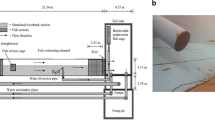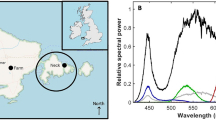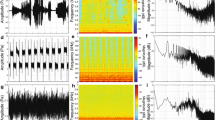Abstract
When dealing with invasive fishes, permanent barriers may be best in preventing spread; however, they may not be feasible due to various costs and/or logistical constraints. Alternatively, various non-permanent barriers using electricity, light, sound, pressure, bubbles, and CO2 are being developed and deployed in efforts to limit the spread of aquatic invasive species or to achieve fish guidance and conservation. However, the effectiveness of these barriers is quite variable, and testing is often lacking for both target and non-target species. We conducted a series of laboratory trials to examine the effects of strobe light on behaviour of Common Carp, Brown Bullhead, and Largemouth Bass. In response to strobe lights, Common Carp and Brown Bullhead stayed significantly farther away compared to the control period and resumed their normal activity once the strobe light was turned off. This suggests that strobe lights may prove to be a useful fish deterrent in the field. Our results also highlight the importance of examining the response of both target and non-target species when evaluating fish deterrent technologies.




Similar content being viewed by others
References
Adams NS, Johnson GE, Rondorf DW, Anglea SM, Wik T (2001) Biological evaluation of the behavioral guidance structure at lower granite dam on the Snake River, Washington in 1998. In: Coutant CC (ed) behavioral Technologies for Fish Guidance. Am fish Soc Symp26. Bethesda, pp 145–160
Bibko PN, Witrenan L, Kuester PE (1974) Preliminary studies on the effects of air bubbles and intense illumination on the swimming behavior of the striped bass (Morone saxatilis) and the gizzard Shad (Dorosoma cepedianum). In: Jensen LD (ed) Entrainment and in-take screening. Proceedings of the second entrainment and intake screening workshop. Electric Power Research Institute, Baltimore, pp 293–304
Brown R (2000) The potential of strobe lighting as a cost-effective means for reducing impingement and entrainment. Environ Sci Pol 3:405–416
Canadian Council on Animal Care. (2005) Guideline on: the care and use of fish in research, teaching and testing http://www.ccac.ca/Documents/Standards/Guidelines/Fish.pdf. Accessed 13 April 2017
Chapman DC, Hoff MH (2011) Invasive Asian carps in North America. Am Fish Soc Symp 74. Bethesda, MD
Chumchal MM, Nowlin WH, Drenner RW (2005) Biomass-dependent effects of carp on water quality in shallow ponds. Hydrobiologia 545:271–277
Crans KD, Pranckevicius NA, Scott GR (2015) Physiological tradeoffs may underlie the evolution of hypoxia tolerance and exercise performance in sunfish (Centrarchidae). J Exp Biol 218:3264–3275
Cudmore B, Mandrak NE, Dettmers J, Chapman DC, Kolar CS (2012) Binational ecological risk assessment of bigheaded carps (Hypophthalmichthys spp.) for the Great Lakes basin. DFO can. Sci. Advis. Sec. Res. Doc. 2011/114, vi + 57 p
Cudmore B, Jones LA, Mandrak NE, Dettmers JM, Chapman DC, Kolar CS, Conover G. (2017) Ecological risk assessment of grass carp (Ctenopharyngodon idella) for the Great Lakes Basin. DFO can. Sci. Advis. Sec. Res. Doc. 2016/118. Vi + 115 p
Davis HS (1967) Culture and diseases of game fishes. University of California press, Berkeley and Los Angeles, pp 75–79
Dawson HA, Reinhardt UG, Savino JF (2006) Use of electric or bubble barriers to limit the movement of Eurasian Ruffe (Gymnocephalus cernuus). J Great Lakes res 32:40–49.
Flammang MK, Weber MJ, Thul MD (2014) Laboratory evaluation of a bioacoustics bubble strobe light barrier for reducing walleye escapement. N Am J Fish Manag 34:1047–1054
Gray SM, Bieber FME, Mcdonnell LH, Chapman LJ, Mandrak NE (2014) Experimental evidence for species-specific response to turbidity in imperilled fishes. Aquat Conserv Mar Freshwat Ecosyst 24(4):546–560
Guthrie DM, Muntz WRA (1993) Role of vision in fish behavior. In: Pitcher TP (ed) Behavior of teleost fishes, 2nd edn. Chapman and Hall, London, pp 89–121
Hamel MJ, Brown ML, Chipps SR (2008) Behavioral responses of rainbow smelt to in situ strobe lights. N Am J Fish Manag 28:394–401
Hawryshyn CW, Harosi FI (1991) Ultraviolet photoreception in carp: microspectrophotometry and behaviorally determined action spectra. Vis Res 31:567–576
Kates D, Dennis C, Noatch MR, Suski CD (2012) Responses of native and invasive fishes to carbon dioxide: potential for a nonphysical barrier to fish dispersal. Can J Fish Aquat Sci 69:1748–1759
Kim J, Mandrak NE (2016) Assessing the potential movement of invasive fishes through the Welland Canal. J Great Lakes Res 42(5):1102–1108
Kimbell HS, Morrell LJ (2015) Turbidity influences individual and group level responses to predation in guppies, Poecilia reticulata. Anim Behav 103:179–185
Kolar C, Chapman D, Courtenay Jr W, Housel C, Williams J, Jennings D (2005)Asian carps of the genus Hypophthalmichthys (Pisces, Cyprinidae) -- a biological synopsis and environmental risk assessment. Report to U.S. Fish and Wildlife Service per interagency agreement 94400-3-0128
Maes J, Turnpenny AWH, Lambert DR, Nedwell JR, Parmentier A, Ollevier F (2004) Field evaluation of a sound system to reduce estuarine fish intake rates at a power plant cooling water inlet. J Fish Biol 64:938–946
Mathis A, Chivers DP, Smith RJF (1996) Cultural transmission of predator recognition in fishes: intraspecific and interspecific learning. Anim Behav 51:185–201
Matsumoto T, Kawamura G (2005) The eyes of the common carp and Nile tilapia are sensitive to near-infrared. Fish Sci 71:350–355
Mesquita FO, Godinho HP, Azevedo PG, Young RJ (2008) A preliminary study into the effectiveness of stroboscopic light as an aversive stimulus for fish. Appl Anim Behav Sci 111:402–407
Nemeth RS, Anderson JJ (1992) Response of juvenile coho and Chinook salmon to strobe and mercury vapor lights. N Am J Fish Manag 12:684–692
Neumeyer C (1992) Tetrachromatic color vision in goldfish: evidence from color mixture experiments. J Comp Physiol A 171:639–649
Noatch MR, Suski CD (2012) Non-physical barriers to deter fish movements. Environ Rev 20:71–82
Patrick PH, Christie AE, Sager D, Hocutt C, Stauffer J Jr (1985) Responses of fish to a strobe light/ air-bubble barrier. Fish Res 3:157–172
Perry RW, Romine JG, Adams NS, Blake AR, Burau JR, Johnston SV, Liedtke TL (2014) Using a non-physical behavioural barrier to alter migration routing of juvenile Chinook Salmon in the Sacramento-San Joaquin river delta. River Res Appl 30:192–203
Richards NS, Chipps SR, Brown ML (2007) Stress response and avoidance behaviour of fishes as influenced by high-frequency strobe lights. N Am J Fish Manag 27:1310–1315
Ruebush BC, Sass GG, Chick JH, Stafford JD (2012) In-situ tests of sound-bubble-strobe light barrier technologies to prevent range expansions of Asian carp. Aquat Invasions 7:37–48
Schilt CR (2007) Developing fish passage and protection at hydropower dams. Appl Anim Behav Sci 104:295–325
Scott WB, Crossman EJ (1973) Freshwater fishes of Canada. Bulletin 184. Fish Res Board of Canada, Ottawa.
Stewart HA, Wolter MH, Wahl DH (2014) Laboratory investigations on the use of strobe lights and bubble curtains to deter dam escapes of age-0 muskellunge. N Am J Fish Manag 34:571–575
Sullivan BG, Wilson ADM, Gutowsky LFG, Patrick PH, Sills M, Cooke SJ (2016) The behavioral responses of a warmwater teleost to different spectra of light-emitting diodes. N Am J Fish Manag 36:1000–1005
Taft EP, Dixon DA, Sullivan CW (2001) Electric Power Research Institute’s (EPRI) research on behavioral technologies. In: Coutant CC (ed) Behavioral technologies for fish guidance. Am Fish Soc Symp26, Bethesda, pp 115–124
Vetter BJ, Cupp AR, FredricksKT GMP, Mesinger AF (2015) Acoustical deterrence of silver carp (Hypophthalmichthys molitrix). Biol Invasions 17:3383–3392
Weber MJ, Brown ML (2009) Effects of common carp on aquatic ecosystems 80 years after “carp as a dominant”: ecological insights for fisheries management. Rev Fish Sci 17:524–537
Zar JH (1996) Biostatistical analysis, 3rd edn. Prentice Hall, Upper Saddle River, New Jersey
Zielinski DP, Voller VR, Svendsen JC, Hondzo M, Mensinger AF, Sorensen P (2014) Laboratory experiments demonstrate that bubble curtains can effectively inhibit movement of common carp. Ecol Eng 67:95–130
Acknowledgements
This study was funded by the Asian Carp Program at Fisheries and Oceans Canada. Field staff at Fisheries and Oceans Canada included David Marson, Kyle Havart-Crans, Justin Barbati, Jason Barnucz, Caitlyn Bondy, Paul Bzonek, D’Arcy Campbell, Catherine Chandler, Mike Clark, Monica Choy, Hadi Dhiyebi, Katarina Doughty, Bradley Doyle, Sydonie Epifani, Robin Gaspardy, Mike Gioseffi, Julie Henry, Meagan Kindree, Ben Kissner, Aaron Law, Liz Miller, Ally Noel, Mike Parna, Alex Price, Edyta Ratajczyk, Natalie Rook, Ashna Tanna, and Nicole Wiemann. Experiments were conducted at Aquatic Life Research Facility, Canada Centre for Inland Waters with logistic support from Alicia Mehlenbacher, Quintin Rochfort, and Jaclyn Gugelyk at Environment and Climate Change Canada. We thank Andrew Court, Jennifer Bowman, and Tys Theysmeyer at Royal Botanical Garden and fishway operation for providing some fish for our experiments. A Visiting Fellowship from Natural Sciences and Engineering Research Council (NSERC), funded by the DFO Asian Carp Program, was provided to JK. This study was conducted according to Animal Use Protocol approved by Animal Care Committee at Canada Centre for Inland Waters.
Author information
Authors and Affiliations
Corresponding author
Rights and permissions
About this article
Cite this article
Kim, J., Mandrak, N.E. Effects of strobe lights on the behaviour of freshwater fishes. Environ Biol Fish 100, 1427–1434 (2017). https://doi.org/10.1007/s10641-017-0653-7
Received:
Accepted:
Published:
Issue Date:
DOI: https://doi.org/10.1007/s10641-017-0653-7




